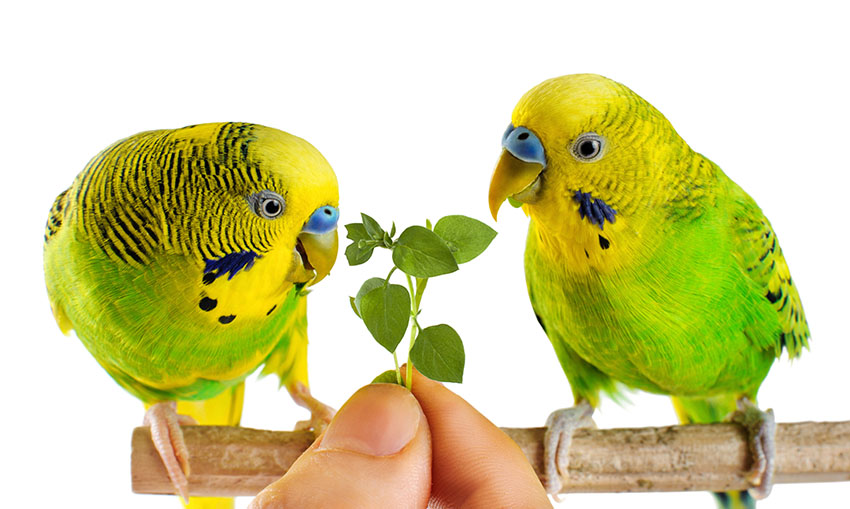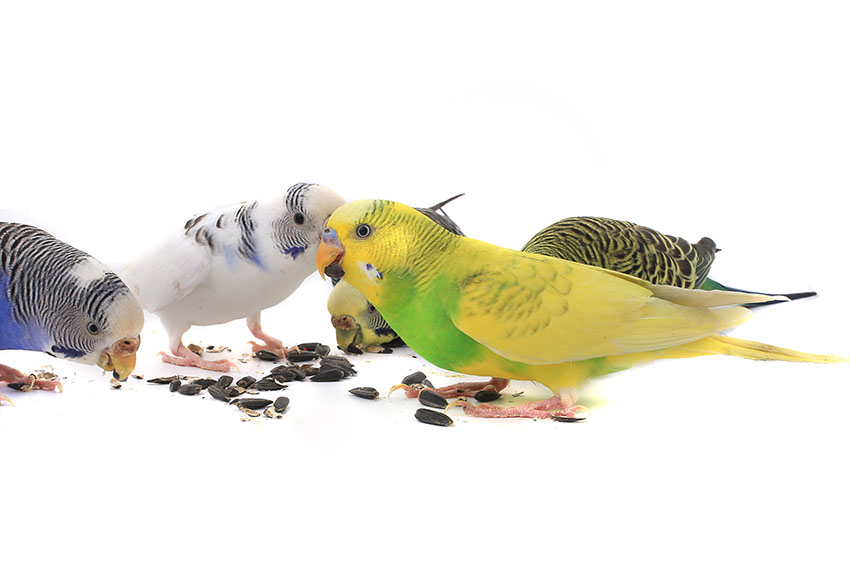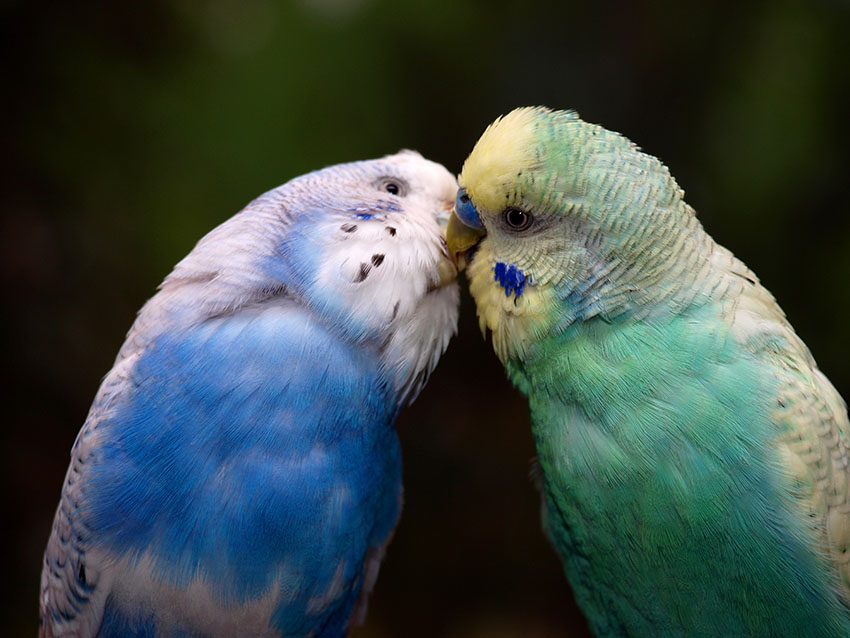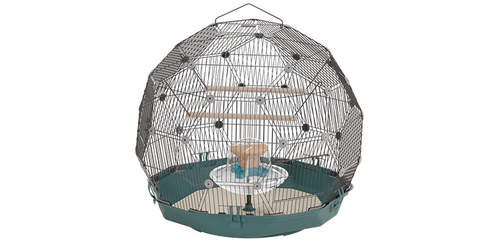The aim when feeding your pet budgerigar is to emulate the birds’ natural diet. This is readily done with a supply of good-quality seed, a mineral supplement block, a regular supply of fruit and greens, and the occasional treat. The seed element should always form the bulk of their diet, though. You must also provide water, as shop-bought seed and pellets will not contain any of the fresh, ‘wet’ seeds that the birds can find in the wild.
Budgie pellets are an alternative ‘all inclusive’ way of feeding your birds. They're formulated to provide everything a budgie needs, but are less popular now than 20 years ago. Unless you're taking home birds that have been raised on pellets, it's best to stick to seeds and fresh food. (See the Feeding budgie pellets section below for more details.)

Fresh food is an important part of a budgie's diet
Fresh food – fruit and greens (see the section on Feeding budgies fresh food, below) – can be offered in dishes, or simply wedged through the bars of the cage.
Staple food (i.e. seed) should always be available for your budgie, and you should check the levels of the feeders and water containers daily. Limit any optional extras, such as sprays of fatty millet or shop-bought and homemade treats, to once a week, otherwise your budgie will be unable to resist gorging himself. Over time he will then become overweight, and his general health will suffer as a consequence.
Budgie Feeding Times
Budgerigars feed several times during the day, which is why the food should always be available. Replenish supplies as appropriate. Taking the food tray or hopper out of the cage in the morning when the lights are first switched on or the curtains opened is a good habit to get into. The newly-woken budgie will soon come to associate the return of the tray with breakfast, a little ritual that will assist your budgie-bonding efforts.
Budgie Feeding Behaviour
Budgies’ usual mode of eating is enthusiastic but cautious. They take a seed or a bite, and then raise their head, alert, while they quickly remove the husk, jiggle the mouthful around with their tongue and swallow. In the wild, this prevents them being surprised by a predator or a cheeky neighbour.

Budgie flocks feed together
In pairs or groups the feeding is a cooperative affair, with a bit of bickering and arguing about favourite perches. In the wild they’re never alone, so they have an inbuilt evolutionary requirement to feed communally without getting into too much of a flap.
Budgerigars have beaks specially adapted for removing the husks from seeds, and a tongue for scooping out the good stuff. The husks are dropped, many falling back in the feeder or hopper, some on the floor of the cage. When the bird flaps its wings in exercise, it will send small clouds of these discarded seed husks into the air, so expect to be sweeping budgie bran from your floor on a regular basis!
Budgies Feeding Each Other
If your cock budgie is feeding a hen bird with regurgitated seed, it’s nothing to worry about. This is a natural part of the courtship behaviour of a male budgerigar, echoing his very endearing habit of vomit-feeding his mate. If there are no proper bird-to-bird courtship opportunities open to your cock budgie, he may regurgitate at a mirror or other object. There's nothing harmful in this, but it may be a sign that his hormones have lurched into mating mode and he's missing the company of his own kind.

Male budgies feed their mates as part of the bonding process
Budgie Digestive System
Birds don’t have teeth – food is swallowed whole and is delivered to the bird’s crop, an organ at the top of its chest cavity. Budgies will often fill their crops to maximum – especially in the wild – using it as a quick-storage space. In captivity budgies usually realise that they don’t need a full crop, and that they can return and browse whenever the mood takes them.
A full crop is visible as a small lump at the base of the budgie’s throat. The crop releases the seed slowly into the digestive system over the course of the day.
Once all the nutrients have been removed from the food via the bird’s two-part stomach, the waste passes through the budgie’s cloaca – the handy, all-purpose bodily exit through which everything passes. The white bits of the droppings are uric acid, the bird equivalent of urine, and the dark bits (lighter in pellet-fed birds) are the poo.
Do Budgies Need Grit?
Because budgies remove the husks from their seeds before swallowing, there is very little indigestible material in their diet. For this reason they do not need grit to help them grind and digest their food. Many birds need grit, but not budgerigars. This does not prevent some pet suppliers from trying to sell you the stuff, though!
Like all birds, budgies’ stomachs have two compartments, including a section called the gizzard. This is the bit that grinds up food. Many standard budgie seed mixes include small bits of insoluble grit, (usually oyster shell). This is not the extraneous grit mentioned above. The bits of shell are dissolved in the gizzard over time and act as a calcium source for the bird. Your bird’s calcium needs, however, should be covered via a mineral block, so even soluble grit isn’t essential.
There are extreme cases of budgies eating too much grit and dying of a blocked crop. The best policy is to never offer insoluble grit, as it serves no purpose and may even lead to problems. If you give them soluble stuff, such as the oyster shells mentioned above, make sure it’s in very small pieces. Check the makeup of your mineral block, though, and if this provides sufficient calcium, don’t bother with grit of any kind.





Comments
Hannah, 27 September 2022
Hi!!! I was wondering what times i should feed my parakeet. and what their bedtimes should be. and how many hours apart should I feed the two main meals.
Sharilyn, 30 June 2021
Robert, many young parakeets will keep a violet colored cere until about 1 year old. If there are white rings right around the nostrils, you have a female. Even in the nest, before their feathers grow in, this can be seen.
Robert, 12 July 2019
Hi there, I bought a pale blue female rainbow budgie its 15 weeks old can you please tell me when the top of the beak will turn blue for a male because I am having doubts about the bird I was sold. I have 1 pale blue hen ? 1 pale cream hen both rainbows and 1 what I call ordinary blue budgie ,they are in a cage 24 x 24 x 48 inches is this a decent size cage for them. I would appreciate if you could answer my questions. Hope to hear from you Mr.Bob Wallace
Jolynn, 20 February 2019
Love budgies. Never knew the required greens. The just love salad mixes.
Gombhira, 26 December 2018
Newsletters about budgie babies in the cage. How to care for them and keep them happy and healthy in the cage